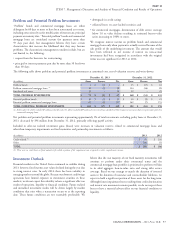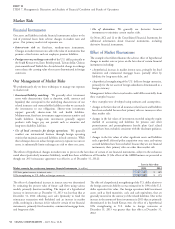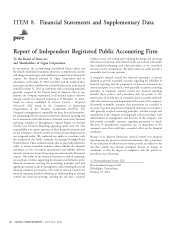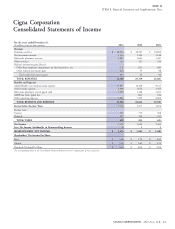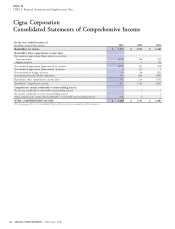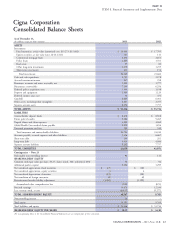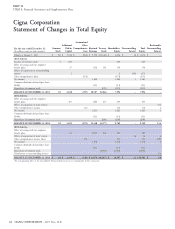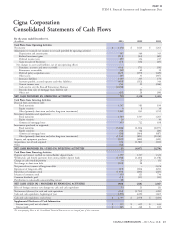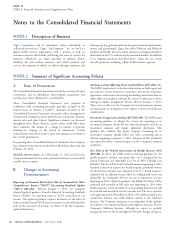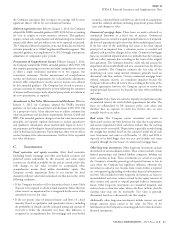Cigna 2013 Annual Report Download - page 99
Download and view the complete annual report
Please find page 99 of the 2013 Cigna annual report below. You can navigate through the pages in the report by either clicking on the pages listed below, or by using the keyword search tool below to find specific information within the annual report.PART II
ITEM 8. Financial Statements and Supplementary Data
the Company anticipates that its impact on earnings will be more securities, estimated future cash flows are also based on assumptions
significant than it will be for our commercial business. about the collateral attributes including prepayment speeds, default
rates and changes in value.
Deferred acquisition costs. Effective January 1, 2012, the Company
adopted the FASB’s amended guidance (ASU 2010-26) on accounting Commercial mortgage loans. These loans are made exclusively to
for costs to acquire or renew insurance contracts. This guidance commercial borrowers at a fixed rate of interest. Commercial
requires certain sales compensation and telemarketing costs related to mortgage loans are carried at unpaid principal balances or, if impaired,
unsuccessful efforts and any indirect costs to be expensed as incurred. the lower of unpaid principal or fair value of the underlying real estate.
The Company’s deferred acquisition costs arise from sales and renewal If the fair value of the underlying real estate is less than unpaid
activities primarily in its Global Supplemental Benefits segment. This principal of an impaired loan, a valuation reserve is recorded and
amended guidance was implemented in 2012 through retrospective adjusted each period for changes in fair value. Commercial mortgage
adjustment of comparative prior periods. loans are considered impaired when it is probable that the Company
will not collect amounts due according to the terms of the original
Presentation of Comprehensive Income. Effective January 1, 2012, loan agreement. The Company monitors credit risk and assesses the
the Company adopted the FASB’s amended guidance (ASU 2011-05) impairment of loans individually and on a consistent basis for all loans
that requires presenting net income and other comprehensive income in the portfolio. The Company estimates the fair value of the
in either a single continuous statement or in two separate, but underlying real estate using internal valuations generally based on
consecutive statements. Neither measurement of comprehensive discounted cash flow analyses. Certain commercial mortgage loans
income nor disclosure requirements for reclassification adjustments without valuation reserves are considered impaired because the
between other comprehensive income and net income were affected Company will not collect all interest due according to the terms of the
by this amended guidance. The Company has elected to present a original agreements; however, the Company expects to recover the
separate statement of comprehensive income following the statement unpaid principal because it is less than the fair value of the underlying
of income and has retrospectively adjusted prior periods to conform to real estate.
the new presentation, as required.
Policy loans. Policy loans are carried at unpaid principal balances plus
Amendments to Fair Value Measurement and Disclosure. Effective accumulated interest, the total of which approximates fair value. The
January 1, 2012, the Company adopted the FASB’s amended loans are collateralized by life insurance policy cash values and
guidance on fair value measurement and disclosure (ASU 2011-04) therefore have no exposure to credit loss. Interest rates are reset
on a prospective basis. A key objective was to achieve common fair annually based on an index.
value measurement and disclosure requirements between GAAP and
IFRS. The amended guidance changes certain fair value measurement Real estate. The Company carries investment real estate at
principles and expands required disclosures to include quantitative depreciated cost less any write downs to fair value due to impairment
and qualitative information about unobservable inputs in Level 3 and assesses impairment when cash flows indicate that the carrying
measurements and leveling for financial instruments not carried at fair value may not be recoverable. Depreciation is generally recorded using
value in the financial statements. Upon adoption, there were no effects the straight-line method based on the estimated useful life of each
on the Company’s fair value measurements. See Note 10 for expanded asset. Investment real estate as of December 31, 2013 and 2012 is
fair value disclosures. expected to be held longer than one year and includes real estate
acquired through the foreclosure of commercial mortgage loans.
Other long-term investments. Other long-term investments include
investments in unconsolidated entities. These entities include certain
Fixed maturities and equity securities. Most fixed maturities limited partnerships and limited liability companies holding real
(including bonds, mortgage and other asset-backed securities and estate, securities or loans. These investments are carried at cost plus
preferred stocks redeemable by the investor) and some equity the Company’s ownership percentage of reported income or loss in
securities are classified as available for sale and are carried at fair value cases where the Company has significant influence, otherwise the
with changes in fair value recorded in accumulated other investment is carried at cost. Income from certain entities is reported
comprehensive income (loss) within shareholders’ equity. The on a one quarter lag depending on when their financial information is
Company records impairment losses in net income for fixed received. Also included in other long-term investments are loans to
maturities with fair value below amortized cost that meet either of the unconsolidated real estate entities secured by the equity interests of
following conditions: these entities and carried at unpaid principal balances (mezzanine
If the Company intends to sell or determines that it is more likely loans). Other long-term investments are considered impaired, and
than not to be required to sell these fixed maturities before their fair written down to their fair value, when cash flows indicate that the
values recover, an impairment loss is recognized for the excess of the carrying value may not be recoverable. Fair value is generally
amortized cost over fair value. determined based on a discounted cash flow analysis.
If the net present value of projected future cash flows of a fixed Additionally, other long-term investments include interest rate and
maturity (based on qualitative and quantitative factors, including foreign currency swaps carried at fair value. See Note 12 for
the probability of default, and the estimated timing and amount of information on the Company’s accounting policies for these derivative
recovery) is below the amortized cost basis, that difference is financial instruments.
recognized as an impairment loss. For mortgage and asset-backed
CIGNA CORPORATION - 2013 Form 10-K 67
C. Investments
•
•


